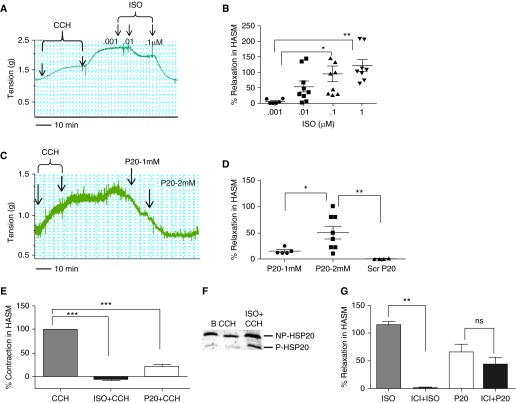Figure 1.
Isoproterenol (ISO) and P20 peptide dose–response curves and phosphorylation of heat shock–related protein (HSP) 20 in human airway smooth muscle (ASM). (A) Representative trace of the dose–response curve of contraction with carbachol (CCH; 0.15 and 0.2 μM) and relaxation with ISO (0.001, 0.01, 0.1 μM) and (B) cumulative data of percent relaxation induced by ISO (0.001–1 μM; *P < 0.01, n = 6–9, **P < 0.001, n = 8). (C) Representative trace of the dose–response curve of contraction with CCH and relaxation with P20 peptide (1 and 2 mM) and (D) cumulative data of percent relaxation induced by P20 peptide (1 and 2 mM) and scrambled (Scr) peptide (2 mM; *P < 0.05, n = 5–8, **P < 0.001, n = 4–7). (E) Cumulative data of percent inhibition of CCH (0.15 μM) contraction induced by pretreatment with ISO (0.5 μM) and P20 peptide (2 mM) in human ASM (HASM; ***P < 0.0001, n = 4–9). (F) ISO induces phosphorylation of HSP20. Representative Western blot of the phosphorylation of HSP20 in response to ISO (0.1 μM) in untreated tissue, basal (B), CCH (0.15 μM), or 0.1 μM ISO plus 0.15 μM CCH–treated ASM. (G) The β2-adrenergic receptor antagonist (±)-1-[2,3-(dihydro-7-methyl-1H-inden-4-yl)oxy]-3-[(1-methylethyl)amino]-2-butanol hydrochloride (ICI 118,551, ICI) inhibits ISO-induced relaxation but does not block P20 peptide (P20)–induced relaxation of HASM. Cumulative data of percent relaxation induced by ISO (0.1 μM) and P20 peptide (1 mM) with and without the presence of 0.2 μM ICI. **Significant compared with ISO (n = 4, P < 0.001); ns, not significantly different from ICI plus P20 (n = 4, P = 0.283).

